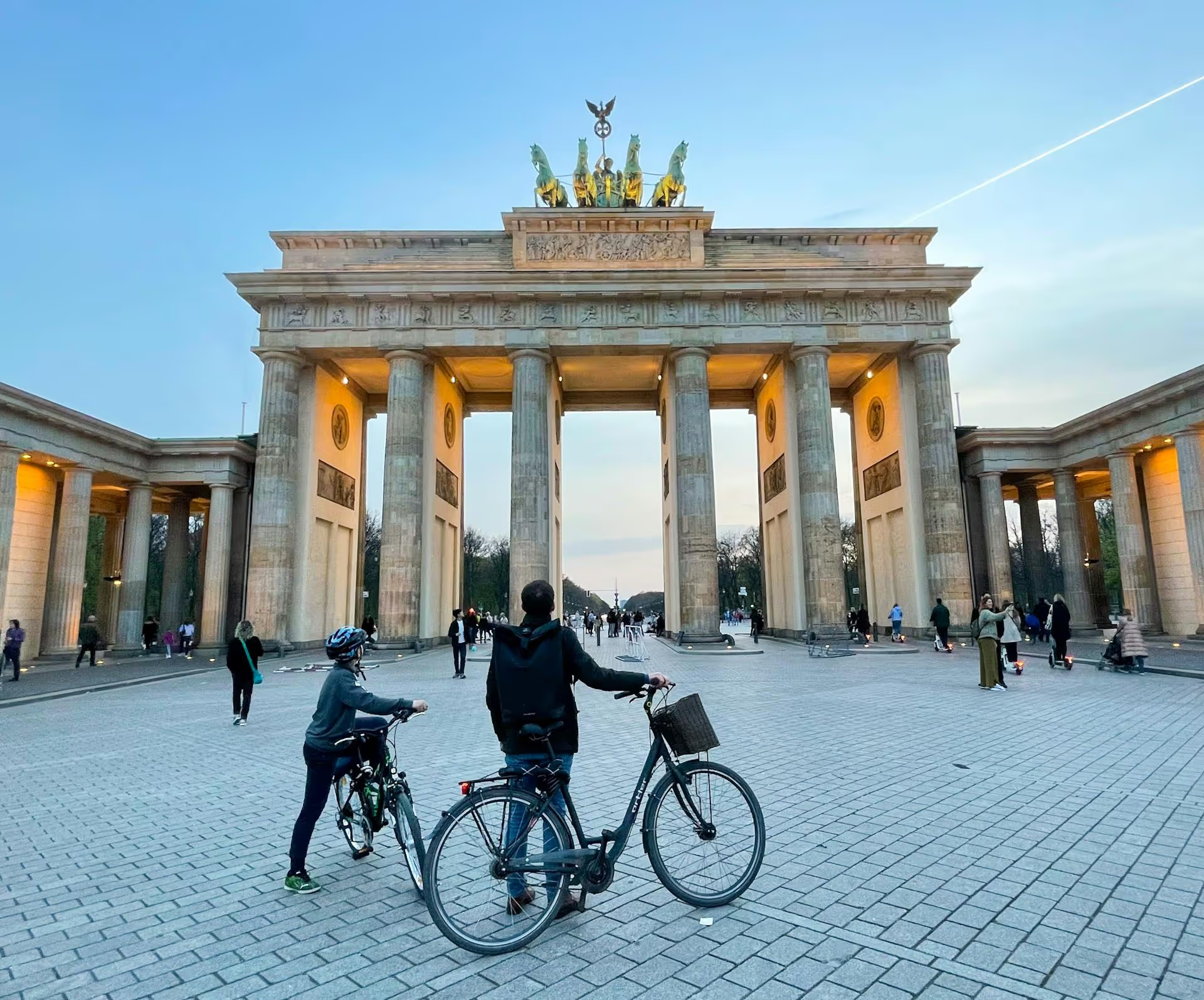
From famous tourist attractions to historic city landscapes, Germany is home to several stunning destinations. If you’re living, whether for studies or work, you’ll want to take advantage of every opportunity to explore Germany. With so much history and regional cultures to indulge in, here are the top ten best cities to visit in Germany, including some of the most famous places in Germany.
Berlin: The Heart of Germany
Berlin is the capital of Germany and is well-known as a melting pot of cultures, history, and modernity. It’s a city that never sleeps and offers something for everyone. You’ll want to visit some must-see historical destinations, including the Berlin Wall Memorial and the Brandenburg Gate. Each site tells a story of Germany’s tumultuous history.
Berlin is famous for its museums and nightlife. During the day, you can explore the city’s history, and at night, you can hit the vibrant streets of neighbourhoods like Kreuzberg and Friedrichhain to experience the nightlife. Clubs like Berghain are world-famous.
It’s also a great place to visit if you want to see one of the best Christmas markets in Germany. Berlin is perfect for everyone who loves urban exploration and cultural diversity.
Munich: Tradition Meets Modernity
As one of the most famous places in Germany, Munich is a Bavarian city where people flock every year for Oktoberfest. It’s a two-week-long celebration with beer, bratwursts, and lots of good cheer from locals and visitors. However, there’s so much more to do in Munich aside from Oktoberfest, especially for history lovers.
You’ll definitely want to explore the beautiful gardens and the several historical sites that are scattered throughout the city, including World War II landmarks. One of the best spots to visit is the Marienplatz, where you can see one of Germany’s tourist attractions: the Rathaus-Glockenspiel. It’s world-famous, so it’s definitely a spot that you won’t want to miss.
Munich is the ideal place to live and visit in Germany for those who like a blend of old-world charm and modern living.
Dresden: The Beautiful Baroque City
Located a short trip away from Berlin, Dresden is another excellent city worth a visit. It is a picturesque urban centre that had its landmarks fully rebuilt after World War II to restore the region’s original charm. Some of these German tourist attractions include the royal Zwinger Palace and Semper Opera House, one of the most beautiful opera houses in the world. Frauenkirche is also one of the famous places in Germany and a symbol of Dresden’s resilience.
Dresden is definitely worth visiting if you are an architecture lover. There are several buildings that display the best of German culture, whether you prefer modern elegance or classic baroque.
Cologne: The Cultural Hub

If you’re looking for some of the best cities to visit in Germany, then you can’t forget about Cologne. The Cologne Cathedral is a must-see spot and a UNESCO World Heritage Site that has become one of Germany’s most popular tourist attractions. It’s a stunning marvel of architecture that is even more unbelievable in person.
You will also enjoy the Old Town or a cruise down the Rhine River. If you visit in February, you will have the chance to experience the lively Cologne Carnival.
Cologne was founded by the Romans and is one of the oldest cities in Germany. It even features a Chocolate Museum, where you can see how cocoa beans are transformed into delicious chocolate that you’ll want to take home with you.
Regensburg: The Medieval Gem
For those who enjoy medieval history, Regensburg is a picturesque city that sits on the Danube River in the southeastern side of the country. It’s also one of Germany’s oldest and most preserved medieval urban centres. There are several landmarks to explore in this stunning riverside city, including St. Peter’s Cathedral and Haidplatz Square.
You can also walk across Stone Bridge and venture through the city’s Old Town, a UNESCO-registered destination that attracts visitors from around the world. Don’t forget to visit Walhalla, a dedicated hall of fame just for exemplary German-speaking figures throughout world history. With its blend of history, culture, and natural charm, Regensburg is a must-visit destination in Bavaria.
Heidelberg: The Romantic Haven
In the southwest of Germany, Heidelberg is located on the Neckar River and has a small-town ambience despite its large population and urban landscape. Heidelberg Castle is one of Germany’s most sought-after tourist attractions, and it is a great place to take a trip to Heidelberg University, the oldest college in Germany. If you love old-world scenery and exploring history, Heidelberg will feel as though you are walking back in time.
Even if you already live and attend Heidelberg University, there’s still plenty to explore, including Philosopher’s Walk and the Old Bridge. Philosopher’s Walk offers you an exceptional view of the old town from the north end of the river, providing you with a glimpse of just how marvelous Heidelberg truly is.
Frankfurt: The Financial Powerhouse
Dubbed the financial capital of Europe, Frankfurt is a captivating city with much more than meets the eye. The city is not only home to the European Central Bank, but there are also plenty of tourist attractions that will keep you busy during your visit. You can explore the Frankfurt Museum Embankment, which has over a dozen museums to choose from.
Frankfurt is also well-known for its Skyline, where you can visit the Main Tower for panoramic view of the city. You can also walk through Römerberg, which is the name of the old city centre that dates back to 1405. It’s a colourful, charming section of the city that has been recreated to reflect Frankfurt’s unique history.
Stuttgart: The Automotive Centre
Stuttgart, the capital of Baden-Württemberg, is known for its rich automotive heritage, vibrant cultural scene, and lush green spaces. Home to the headquarters of Mercedes-Benz and Porsche, the city features must-visit museums dedicated to these iconic car brands. Stuttgart also offers cultural attractions like the Staatsgalerie, the Stuttgart Ballet, and the stunning Wilhelma, a unique combination of zoo and botanical garden.
Set amidst picturesque hills and vineyards, Stuttgart combines natural beauty with urban sophistication. There are lots of parks in the city, such as the Schlossgarten, where you can enjoy outdoor activities. Stuttgart’s lively festivals, like the Cannstatter Volksfest, and its diverse culinary scene further add even more allure.
Hamburg: The Maritime Metropolis
Along the Elbe River, Hamburg is home to the largest port in the country for cruise ships, and it is a beautiful place to visit if you want to venture by boat. However, you can also walk the city to see essential spots like the Alter Elbtunnel or even the Planten un Blomen Park.
If you’re a fan of model trains, you’ll need to visit Miniatur Wunderland, which is the world’s most extensive model railway system. You can also catch any number of concerts here at one of the two concert halls at the Elbphilharmonie complex. To get a taste of the Hamburg’s nightlife and entertainment scene, Reeperbahn, known as the “most sinful mile” is a must-visit.
Nuremberg: A City Rich in History
Last, but certainly not least is Nuremberg, one of the most famous spots in Bavaria. This is a must-see spot because it has been so well-preserved, both from medieval times and since World War II. You can visit several historical spots that relate to the pre-World War II years and the war years. Nuremberg Trials Memorial would be worth a visit for everyone interested in World War II history.
If you want to see spots that date back to the Roman Empire, take a trip to the Imperial Castle in Old Town or simply walk through the charming city streets. You can also stop by the world’s oldest sausage restaurant for a bite to eat.
Nuremberg is also home to one of the oldest and most famous Christmas Markets in Germany and is a must-visit during the holiday season.
FAQs
Find answers to common questions about living in Germany.
Which city is best to stay in Germany?
This depends on your preferences. Berlin is ideal for longer stays thanks to its international atmosphere, affordable living compared to other big cities, and endless activities. Munich is great for those who want high quality of life, access to the Alps, and a mix of tradition and modernity, although it is more expensive. Frankfurt is perfect for professionals, as it’s the country’s financial hub and very international. Hamburg offers a blend of modern architecture, a thriving music scene, and waterside living. For students or creatives, cities like Leipzig or Dresden offer a vibrant but more affordable lifestyle.
Where should I go for my first time in Germany?
It depends on your preferences. If you’re visiting Germany for the first time, Berlin is usually the best place to start. The capital offers a mix of everything: world-famous landmarks like the Brandenburg Gate, remnants of the Berlin Wall, vibrant neighborhoods, and some of the best nightlife in Europe. You’ll get a sense of Germany’s modern and historic identity all in one place. For a different experience, you could also start in Munich, which is known for its Bavarian culture, beer gardens, and proximity to the Alps. Both cities are well connected by transport, making them easy entry points for first-time visitors.
What's the prettiest town in Germany?
One of the prettiest towns in Germany is Rothenburg ob der Tauber, a perfectly preserved medieval town with cobbled streets and half-timbered houses. It looks straight out of a fairytale and is part of the popular “Romantic Road” tourist route. Other scenic options include Heidelberg, with its riverside castle and historic university, and Bamberg, known for its UNESCO-listed old town and unique smoked beer. Smaller towns like Quedlinburg or Görlitz also charm visitors with their historic beauty and picturesque old streets.
What is the nicest German city to visit?
Germany has many “nice” cities, depending on what you’re looking for. Berlin is best for history lovers and those who want a dynamic cultural scene. Munich appeals to travelers looking for elegance, beer gardens, and Alpine day trips. Cologne is famous for its stunning Gothic cathedral and friendly atmosphere, while Hamburg offers canals, a bustling port, and modern architecture. Even smaller cities like Dresden and Leipzig are rising in popularity for their art, music, and historic charm.
What are the must visit places in Germany?
Germany has a long list of must-see places, and many travelers plan their trip around them. Berlin’s landmarks (such as the Brandenburg Gate, Museum Island) are essential for history and culture lovers. Neuschwanstein Castle in Bavaria, the inspiration for Disney’s castle, is one of the most photographed sites in the world. Nature lovers shouldn’t miss the Black Forest, the Rhine Valley with its castles and vineyards, or the Bavarian Alps. For a taste of city life, Cologne Cathedral, Hamburg’s port, and Munich’s Marienplatz are all iconic. Together, these destinations show off Germany’s incredible variety.
What are the big 7 cities in Germany?
Germany’s “big seven” cities are: Berlin, Hamburg, Munich, Cologne, Frankfurt, Stuttgart, and Düsseldorf. These are the largest and most influential urban centers in the country.
Get Your Visa-Ready Package
Start your journey to Germany with our all-in-one visa solution tailored for your needs.
More About Living in Germany
From seasonal weather patterns to festive traditions - everything you need to know about life in Germany




